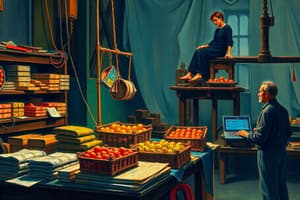Podcast
Questions and Answers
Qual es le principal focu del SDLC?
Qual es le principal focu del SDLC?
- Organizar le programmas e portefolios
- Facilitar le outsourcing de systemas
- Regolar le phases del devolvemento de systemas (correct)
- Gestir le projectos de forma flexible
Qual es un differentia key inter project management e program management?
Qual es un differentia key inter project management e program management?
- Program management non tiene relation con le status report.
- Program management non pote includer project management.
- Project management se concentra in le initiativas unice. (correct)
- Project management es concernite con le long-term outcomes.
Quo implica le processus de digital transformation?
Quo implica le processus de digital transformation?
- Un cambio in le infrastructura IT solmente.
- Le adoptamento de un software sin cambio operational.
- L'integration de technologia in omne aspectos del negotio. (correct)
- Le focus exclusive super le venditas online.
Qual es un exemplo de gamification?
Qual es un exemplo de gamification?
Quel es le differente inter augmented reality e virtual reality?
Quel es le differente inter augmented reality e virtual reality?
Qual es un caracteristica principale de quantum computing?
Qual es un caracteristica principale de quantum computing?
Quo implica le concept de crowdsourcing?
Quo implica le concept de crowdsourcing?
Quo es le objectivo de un request for proposal (RFP)?
Quo es le objectivo de un request for proposal (RFP)?
Flashcards
SDLC
SDLC
Le System Development Life Cycle (SDLC) es un methodo structured pro le developmento de systemas de information. Il se divide in phases distinct como planifica, analyse, design, implementation, teste, e mantenimento.
Waterfall Model
Waterfall Model
Le Waterfall Model es un modello de developmento de software classic que sequi un processo linear. Un phase debe esser complete ante que le proxime pote comenciar.
Project Management
Project Management
Le processo de planificar, organizar, e controlar recursos pro completar un objectivo specific in un periodo de tempore definite.
GANTT Chart
GANTT Chart
Signup and view all the flashcards
Program Management
Program Management
Signup and view all the flashcards
Portfolio Management
Portfolio Management
Signup and view all the flashcards
Augmented Reality (AR)
Augmented Reality (AR)
Signup and view all the flashcards
Virtual Reality (VR)
Virtual Reality (VR)
Signup and view all the flashcards
Study Notes
ERP - Enterprise Resource Planning
- A tool for managing organizational information
- Organizes, collects, stores, and uses information for the benefit of an organization
- Success relies on organization and technology factors before, during, and after implementation
- Enterprise Systems include large application software for processes, information, data flows, reporting and data analytics in complex organizations
- A central feature of all ERP systems is a shared database supporting multiple organizational business functions
- POM (Production & Operations Management) software aims to optimize workflows (production or service delivery)
- Inventory Control Systems aim to minimize inventory costs (holding, ordering & shipping) and shortage costs
Computer-Integrated Manufacturing Systems
- Uses computers and automation to control the entire manufacturing/production process
- Aims to remove barriers between different organizational functions, promoting close cooperation throughout the process
- Improves production control and reduces costs
Transportation Management Systems
- Handle transportation planning (shipping, consolidation, load & trip planning, route planning, and carrier selection)
- Aims to reduce costs and improve customer service
Logistics Management
- A subset of TMS, coordinating inbound and outbound logistics
- Optimizes transport operations and coordinates with suppliers
Sales Management Systems
- Integrates supply chain technologies
- Synchronizes inbound/outbound material flows
- Manages distribution/transport networks
- Combines different sales procedures and tasks to provide a detailed overview of salespeople, products, location, and customers to help track sales & achieve goals quickly
Financial Planning & Budgeting Systems
- Helps organizations create and manage budgets
- Improves the ability to monitor performance
- Identifies deviations from planned activities, quickly
Human Resource Information Systems (HRIS)
- Centralized employee master data repository
- Supports human resource processes (forecasting needs, skill development)
Supply Chain Management Systems (SCM)
- Manages material acquisition, manufacturing, transportation, delivery, and recycling product disposal
- Effectively manages material, data, and payment flows among companies within the supply chain from suppliers to consumers
Digital Supply Chain Map
- Shows the complete life cycle of a product from raw material to consumer
- Includes warehouses, shipping, manufacturing, and retail distribution centers
Software Development Life Cycle (SDLC)
- A set of activities, methods, deliverables, and tools for creating and maintaining IT architecture/software.
- Like building, needs framework before design
- Stages: systems planning, systems analysis, design, implementation, testing, support, maintenance.
- Iterative, not linear
- Planning stage defines feasibility of the request.
Systems Design & Development
- Developers use design specifications to create user interfaces.
- Includes hardware/software acquisition, user-system documentation
- Implementation: conversion of old to new systems (plunge, parallel, pilot, phased for specific components).
- Testing verifies applications, interfaces, data transfers, under various conditions.
- Training for users for new systems.
- Support & maintenance: ensures consistent operations, audits assess capabilities.
- SDLC as Waterfall Model (planning, analysis, design, implementation, testing, support & maintenance).
Project, Program, and Portfolio Management (PPPM)
- Project: temporary effort for outputs.
- Program: group of related projects.
- Portfolio: collection of unrelated programs.
- Project management successfully guides projects from initiation to completion with established guidelines, procedures, and policies.
- Project success relies on engaged sponsors, organizational strategy alignment, and high project management technology (PMTQ)
Triple Project Constraint
- Scope: project goals
- Time: completion deadline
- Cost: budget
Project Initiation (SOW)
- A definitive statement of work, outlining the project plan but without options.
- Work Breakdown Structure (WBS) identifies all tasks and roles.
Gantt Chart
- Timeline to show project and schedule, tracking progress and tasks.
Program Management
- Manages related projects as a group (better resource utilization than individual projects).
- Provides support for project completion and quality.
Portfolio Management
- Centralized strategic management for proposed/ongoing/future projects.
Project Development vs. Product Development
- Projects have defined end-points.
- Products, if successful, remain ongoing.
- Products usually target multiple customers, while projects often aim for a single customer.
Digital Transformation
- Adapting organizations, processes, and technology to adapt to digital technologies and data analytics.
International Technology Considerations
- Addressing country-specific factors, including language, infrastructure (bandwidth/WIFI), culture, dates, payment systems, and shipping, for international software/services.
Customer Journey Mapping
- Understanding customer interactions with a product or service to identify pain points and opportunities.
- Key considerations include users, frustrations at process steps, how various factors affect cost and urgency, and the process steps that are long, painful.
Quantum Computing
- Based on quantum mechanics, for information processing.
- Unlike classical circuits (0 or 1), qubits represents 0 and 1 simultaneously (superposition, entanglement, interference)
- Has advantages in tasks like optimization, data analysis, or simulations while classical computing is better for everyday tasks.
Augmented Reality (AR) vs. Virtual Reality (VR)
- AR: images on real-world views (e.g., Pokemon Go).
- VR: immersive digital worlds (e.g. Facebook's Metaverse, Playstation virtual games).
- Extended Reality (XR): combining AR and VR for a more realistic experience.
3D Printing (Additive Manufacturing)
- Layer-by-layer construction, using computer-aided design models.
- Complex, lightweight products.
- Increasing demand for manufacturing.
Gamification
- Strategic approach to motivate and strengthen engagement with customers, employees.
- Leveraging game-like principles (challenges, progression, rewards) for increased motivation and productivity.
Ethics
- Values driving ethical decisions in a company.
- Ethical behavior aligning with societal values.
- Organizations (or individuals) have a set of principles and rules to guide their decisions.
- A company's code of ethics shows how it operates in a transparent and responsible manner.
Risk and Compliance
- Crowd sourcing involves obtaining ideas, content, or services from various people.
- Encourages diverse viewpoints and problem-solving.
Outsourcing
- Outsourcing involves using external providers for software development, infrastructure, and services (offshoring, cloud services).
- Outsource life cycle includes assessment, preparation, contract negotiation, transition, monitoring (managing SLAs).
Infrastructure Strategy
- Assess current capacity to handle future digital initiatives and strategic plans
Studying That Suits You
Use AI to generate personalized quizzes and flashcards to suit your learning preferences.




